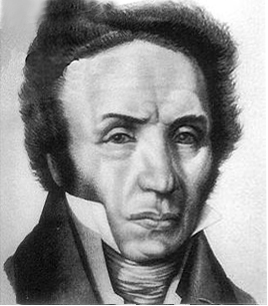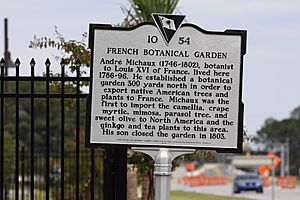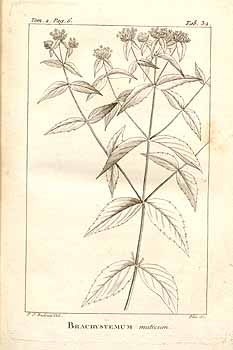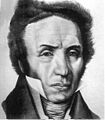André Michaux facts for kids
Quick facts for kids
André Michaux
|
|
|---|---|
 |
|
| Born | 8 March 1746 Satory, Versailles, France
|
| Died | 11 October 1802 (aged 56) Tamatave (Toamasina), Madagascar
|
| Citizenship | French |
| Children | François André Michaux |
| Scientific career | |
| Fields | Botany |
| Academic advisors | Bernard de Jussieu |
| Author abbrev. (botany) | Michx. |
André Michaux (born March 8, 1746 – died October 11, 1802) was a famous French botanist and explorer. He is best known for studying plants in North America. Michaux also gathered plant samples in England, Spain, France, and even Persia (modern-day Iran). His work helped Europe learn more about the natural world.
Michaux wrote important books like Histoire des chênes de l'Amérique (1801), which means "The Oaks of North America." He also wrote Flora Boreali-Americana (1803), meaning "The Flora of North America." These books were used by botanists for many years. His son, François André Michaux, also became a respected botanist.
Contents
André Michaux's Amazing Journeys
André Michaux was born in Satory, a part of Versailles in France. His father managed farms on the king's land. André learned about farming to take over his father's job one day. He also got a basic education, including Latin and some Greek, until he was fourteen.
In 1769, he married Cecil Claye, but she sadly died a year later while giving birth to their son, François André. After this, Michaux started studying botany, which is the science of plants. He became a student of Bernard de Jussieu, a famous botanist.
In 1779, Michaux studied plants in England. In 1780, he explored areas in France and northern Spain. In 1782, the French government sent him on a plant-collecting trip to Persia. His trip started tough when his equipment was stolen. But he gained important support in Persia after helping the local ruler with a serious illness. After two years, he returned to France with a great collection of dried plants (a herbarium). He also brought many plants from the East to French gardens.
In 1785, King Louis XVI of France sent André Michaux to the United States. His job was to find plants that could be useful for building, medicine, and farming in France. He traveled with his son, François André Michaux, through Canada and the United States.
In 1786, Michaux tried to start a plant garden in New Jersey. But the cold winters made it difficult, and the garden didn't succeed. In 1787, Michaux started another botanical garden in North Charleston, South Carolina. This garden was much larger and he kept it for ten years. From this garden, he made many trips to different parts of North America.
During this time, Michaux described and named many new plant species in North America. Between 1785 and 1791, he sent ninety cases of plants and many seeds back to France. He also brought new plants to America from other parts of the world, like Camellia, tea-olive, and crepe myrtle.
When the French government changed, André Michaux, who was a royal botanist, lost his funding. He asked the American Philosophical Society to support his next exploration. In early 1793, Thomas Jefferson asked him to lead an expedition to explore westward. This was similar to the Lewis and Clark Expedition that happened later.
Michaux was involved in a plan to explore the western territories, but it didn't work out. He went to Kentucky, but the plan couldn't go forward without enough money. It's not true that Thomas Jefferson ordered Michaux to leave the United States because of this. Jefferson knew about Michaux's involvement and even helped him with letters of introduction.
Michaux returned to France in 1796. His ship was wrecked, but most of his plant samples survived! His two gardens in America were not kept up well. The New Jersey garden is still remembered as "The Frenchman's Garden" today.
In 1800, Michaux sailed with an expedition to Australia, but he left the ship in Mauritius. He then went to Madagascar to study the plants there. André Michaux died in Madagascar on October 11, 1802, from a tropical fever. He did most of his work out in the field, exploring and collecting. He greatly increased what was known about plants in the East and in America.
In 1800, Pierre Samuel Du Pont de Nemours visited the United States and was worried about Michaux's abandoned gardens. He wrote to the Institut de France, who sent Michaux's son, François André Michaux, to sell the properties. He sold the garden near Charleston. However, the New Jersey garden was saved and continued to be supported.
Michaux's Legacy
- The Carolina lily and Michaux's saxifrage are among several plants named after him.
- Michaux State Forest in Pennsylvania, U.S., which protects over 85,000 acres, is named for him.
- The André-Michaux Ecological Reserve in Quebec, Canada, protecting 450 hectares, is also named for him.
- His son, François André Michaux, published an important book called Histoire des arbres forestiers de l'Amérique septentrionale (1810–1813), which means "History of Forest Trees of Northern America."
- Michaux Stone: Michaux brought a special stone called a kudurru back from his trip to the Near East. This stone was found near an ancient Babylonian town. Michaux sold the stone to a French museum in 1800, and it is now in the Bibliothèque Nationale in France.
Michaux's Writings
Michaux wrote two very important books about North American plants. These are the Histoire des chênes de l'Amérique septentrionale (1801), which has 36 pictures, and the Flora Boreali-Americana (1803), with 51 pictures. Even though the 1803 book seemed to be by the father, his son François said later that he and another botanist finished and published it after his father's death.
See also
- Taxa named by André Michaux
- European and American voyages of scientific exploration
- François Cagnet
Images for kids





